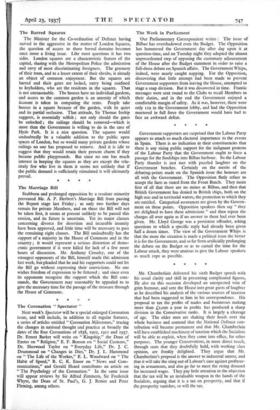The Barred Squares The Minister for the Co-ordination of Defence
having moved to the aggressive in the matter of London Squares, the question of access to those barred domains becomes once more a living issue. Like most questions it has two sides. London squares are a characteristic feature of the capital, sharing with the Metropolitan Police the admiration and envy of most discriminating foreigners. The greenery of their trees, and to a lesser extent of their shrubs, is already an object of common enjoyment. But the squares are barred and their gates are locked, entry being confined to keyholders, who are the residents in the squares. That is not unreasonable. The houses have no individual gardens, and access to the common garden is an amenity of which account is taken in computing the rents. People take houses in a square because of the garden, with its quiet and its partial seclusion. That attitude, Sir Thomas Inskip suggests, is essentially selfish ; not only should the gates be unlocked ; the railings should be removed—which is more than the Government is willing to do in the case of Hyde Park. It is a nice question. The squares would undoubtedly be a valuable addition to the public open spaces of London, but so would many private gardens whose railings no one has proposed to remove. And it is idle to suggest that they would retain their present charm if they became public playgrounds. But since no one has much interest in keeping the squares as they are except the rela- tively few who live in them it seems not unlikely that if the public demand is sufficiently stimulated it will ultimately prevail.
* *










































 Previous page
Previous page